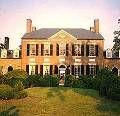
Federal and Adam (1780s – 1840s)
Graceful details distinguish Federal homes from the pragmatic Georgian colonial style.
History:
Like much of America’s architecture, the Federal (or Federalist) style has its roots in the British Isles. Two Scottish brothers named Adam adapted the pragmatic Georgian style, adding swags, garlands, urns, and other delicate details. In the American colonies, homes and public buildings also took on graceful airs. Inspired by the work of the Adam brothers and also by the great temples of ancient Greece and Rome, Americans began to build homes with Palladian windows, circular or elliptical windows, recessed wall arches, and oval-shaped rooms. This new Federal style became associated with America’s evolving national identity.
It’s easy to confuse Federalist architecture with the earlier Georgian Colonial style. The difference is in the details: While Georgian homes are square and angular, a Federal style building is more likely to have curved lines and decorative flourishes. Federalist architecture was the favored style in the United States from about 1780 until the 1830s. However, Federalist details are often incorporated into modern American homes.
Features:
Low-pitched roof, or flat roof with a balustrade
Windows arranged symmetrically around a center doorway
Semicircular fanlight over the front door
Narrow side windows flanking the front door
Decorative crown or roof over front door
Tooth-like dentil moldings in the cornice
Palladian window
Circular or elliptical windows
Shutters
Decorative swags and garlands
Oval rooms and arches
Next: Greek Revival Style